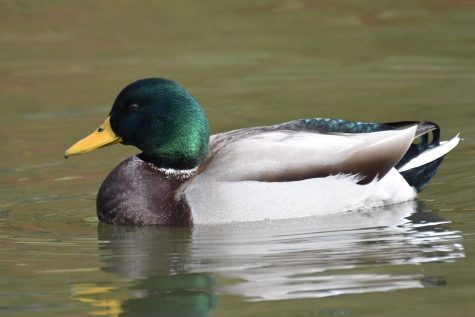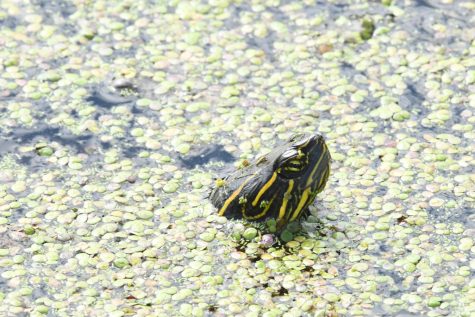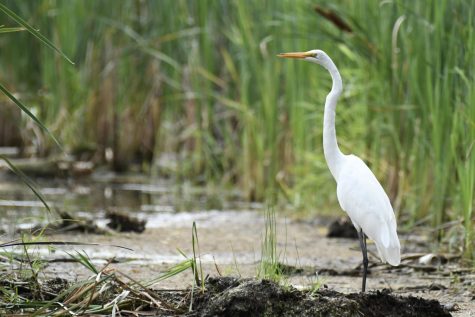It takes tributaries
February 21, 2023
In the beautiful Land of 10,000 Lakes, we are privileged with more coastline than the whole state of California. Our great water resources provide recreation, beautiful locations, food and drinking water. Living with so much freshwater requires awareness and responsibility.
This article will focus on groundwater and surface water. The Oracle had the privilege of speaking with Jessica Bromelkamp, the communications and engagement division manager of the Capitol Region Watershed District (CRWD) for insight. The CRWD is a local organization that works throughout the community to assist and consult on projects dedicated to improving water management in Saint Paul.

Surface water
All of the lakes within the CRWD eventually flow into the Mississippi. Because we reside in the Upper Mississippi River basin, our actions make an impact on all of the states south of us that also utilize and care for the Mississippi before it reaches the Gulf of Mexico.
Without taking more adequate care of the Mississippi, we can likely expect to experience more mass fish die off such as that near Winona last year when 2,500 trout died due to unnatural causes that have been difficult to investigate fully.
The CRWD does a lot of work in urban environments to address our water pollution. Green spaces such as rain gardens and tree trenches around the Green Line and University Avenue serve to absorb stormwater to reduce erosion and filter pollutants before rainwater continues on its journey to our local lakes and rivers.
When you walk down University, you can usually see educational signs about the landscaping methods and purposes. Why do this?
“Melting snow or rain washes all the pollution off the roads and sidewalks to a storm drain and directly out to the river. So we do a lot of projects … that are largely focused on capturing runoff and either finding a way to reuse it or allowing it to soak back into the ground instead of carrying pollution to the river,” Bromelkamp said.

The landscaping and water management infrastructure around the Greenline within the CRWD is expected to remove approximately 40,000 pounds of sediment and significantly reduce run-off.What exactly are the water quality issues that impact urban environments such as the Hamline campus and within our watershed district?
“One of the things that we look a lot at is how much phosphorus is getting into our water bodies. And that can happen naturally from decaying organic matter,” Bromelkamp said.
When dead leaves and grass are left on storm drains, this results in organic debris getting washed out to the Mississippi, causing algae blooms that can suffocate fish, threaten freshwater ecosystems and stink up our cities. To help reduce this problem, you can adopt-a-drain and join city clean up initiatives throughout St. Paul.
Another way we can reduce phosphorus contamination in surface water is through rain gardens that soak and filter stormwater run-off instead of letting it flow directly into the storm drains. There are many excellent native plants available for this purpose, The CRWD pocket park also provides us with an example!
Phosphorus is not the only urban-based source of chemical pollution in our surface water. Increased salinity in our freshwater lakes and rivers makes it more difficult for native ecosystems and aquatic life to survive and thrive. Chlorides have also polluted aquifers that source our drinking water.
Bromelkamp said, “thinking about getting your sidewalks and driveways as clear as you can with a shovel before applying salt and asking yourself ‘what’s the right amount of salt right now?’ … Once the salt is in the water, it’s very difficult to get out, so prevention and education are kind of the best methods to get the word out about smarter salting.”
When you over-salt your driveway, that can get washed down storm drains as the snow melts and it can have a terrible impact on our aquatic surroundings. The CRWD currently conducts research on chloride levels in Minnesota to monitor and the Minnesota Pollution Control Agency highlights that salinity has been increasing both in surface and ground-level freshwater.
In response to this problem, the Minnesota Pollution Control Agency, Hennepin County Chloride Initiative and CRWD conduct training on appropriate ice salting practices. Think carefully next time before you spill the salt!

Groundwater
Data from the Minnesota DNR states that groundwater supplies 75% of Minnesota’s drinking water and 90% of agricultural irrigation.
For my dear readers who are not familiar with the term, groundwater refers to water from underground, generally located in aquifers. Aquifers are restocked with water from rainwater that seeps through the ground, and this is a matter of particular concern because Minnesota has been impacted by drought for the past few years.
In 2021, Warren, Minnesota’s aquifers, suffered drastic water volume loss as a result of high agricultural use and drought. As climate change continues to rage on, we have to prepare for continued drought conditions throughout Minnesota.
One way to prepare is by making the best use of the water we do get right now. We could further utilize the rain we do receive instead of relying on aquifer-sourced water as often. The CRWD office does this by using a large tank that stores and processes rainwater.
Think of the rain as a resource. In the past, streams have been redesigned to move water away from people in cities. “If we think of more rain, as a resource like our cistern here, we can use the water that we get during rainstorms for other purposes. So in the case of the building we have here, we actually use it to flush toilets,” Bromelkamp told me.
Now, I understand that not everyone is able to install a giant tank in their house, especially students who rent, but you can store rainwater for watering your gardens instead of relying on aquifer-sourced water from your hoses. Storing and using rainwater has a double benefit of reducing floods and run-off pollution when we do get rainstorms.
Another water conservation effort centers around reusing water, which will rely on infrastructural changes on our campus. We can take inspiration from the CHS field, which was built with sustainability in mind.
CHS collects and utilizes rainwater that is filtered through different natural elements such as tree trenches or even sand trenches around the field. A large cistern then processes and stores water to be re-used for non-potable (not suitable for consumption) purposes including toilet water and for watering the baseball field. CHS field is estimated to save up to 450,000 gallons of water per year, reducing significant strain on aquifers.
As a student, what can you do? Bromelkamp suggests that we think about how much water we use and where it comes from. So consider your water practices, and the impact it has!
